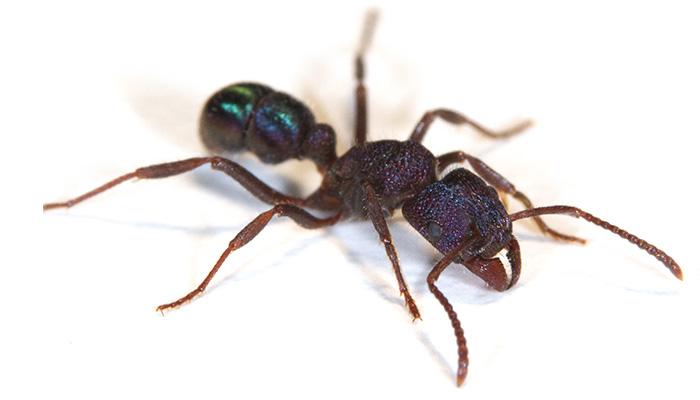IMB researchers have shown for the first time that some of the world’s most painful ant stings target nerves, like snake and scorpion venom.
Dr Sam Robinson and colleagues at UQ’s Institute for Molecular Bioscience discovered the ant neurotoxins while studying the Australian green ant and South American bullet ant which have stings that cause long-lasting pain.
Targeting nerve cells
“We have shown that these ant venoms target our nerve cells that send pain signals,” Dr Robinson said.
“Normally, the sodium channels in these sensory neurons open only briefly in response to a stimulus.
“We discovered that the ant toxins bind to the sodium channels and cause them to open more easily and stay open and active, which translates to a long-lasting pain signal.
Stings painful for up to 12 hours
“Bullet ant stings can be painful for up to 12 hours and it’s a deep drilling pain you feel in your bones with sweating and goosebumps, quite unlike the 10-minute impact of a typical bee sting.
“We don’t have bullet ants in Australia, but our green ant (or greenhead ant) can also cause long-lasting pain and many Australians will have experienced this.”
The bullet ant was rated as having the most painful insect sting in the world by the late Dr Justin Schmidt, an American entomologist who created a pain index of stinging insects.

Fantastic tools to learn how pain works

Dr Robinson said research into how pain works can help develop new ways to treat it.
“We want to understand pain at a molecular level and toxins are fantastic tools to do this,” he said.
“These neurotoxins which target sodium channels are unique to ants, no one has found anything that looks or acts the same way so now we have a new set of tools to work with.”
Evolved to fend off predators
Ants developed their defensive neurotoxins to fend off predators during the time of the dinosaurs and have since become one of the most successful animal groups on Earth.
The research team included Dr Jennifer Deuis, Dr Angelo Keramidas, Professor Irina Vetter and Professor Glenn King from IMB and the late Dr Schmidt from the Southwestern Biological Institute, Arizona.
This research is published in Nature Communications.



